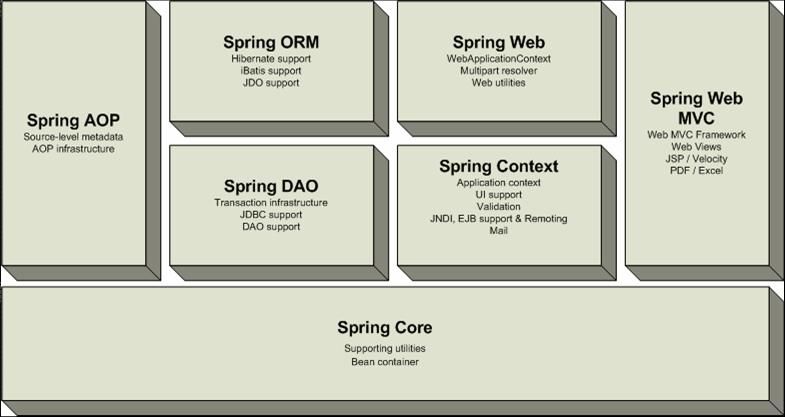
1. The Core container
- The core container provides the essential functionality of the Spring framework.
- This module is the fundamental module of spring framework. The Spring framework was developed on top of this module.
- A primary component of the core container is the BeanFactory, an implementation of the Factory pattern.
The BeanFactory applies the Inversion of Control (IOC) pattern to separate an application's configuration and dependency specification from the actual application code.
2. Spring context (Application Context)
- Spring is called a framework because of this module.
- The Spring context is a configuration file that provides context information to the Spring framework.
- The Spring context includes enterprise services such as JNDI, EJB, e-mail,internalization, validation, and scheduling functionality.
3. Spring AOP
- Used for developing aspects for our Spring-enabled application.
- Integrates aspect-oriented programming functionality directly into the Spring framework, through its configuration management feature.
- You can easily AOP-enable any object managed by the Spring framework.
- Provides transaction management services for objects in any Spring-based application.
You can incorporate declarative transaction management into your applications without relying on EJB components. - Using Spring’s metadata support, we can add annotations to source code that instruct Spring on where and how to apply aspects.
4. Spring DAO
- Offers a meaningful exception hierarchy for managing the exception handling and error messages thrown by different database vendors.
The exception hierarchy simplifies error handling and greatly reduces the amount of exception code you need to write, such as opening and closing connections. Spring DAO's JDBC-oriented exceptions comply to its generic DAO exception hierarchy. - Keep up the database code clean and simple, and prevent problems that result from a failure to close database resources.
- This module uses Spring’s AOP module to provide transaction management services for objects in a Spring application.
5. Spring ORM
- Supports use of an object / relational mapping (ORM) tool over straight JDBC by providing the ORM module.
- The Spring framework plugs into several ORM frameworks to provide its Object Relational tool, including JDO, Hibernate, and iBatis SQL Maps. All of these comply to Spring's generic transaction and DAO exception hierarchies.
- Spring’s transaction management supports each of these ORM frameworks as well as JDBC.
6. Spring Web module
- The Web context module builds on top of the application context module, providing contexts for Web-based applications.
- Spring framework supports integration with Jakarta Struts.
- Eases the tasks of handling multi-part requests and binding request parameters to domain objects.
- Allows you to declaratively bind request parameters to your business objects.
- It also can take advantage of any of Spring’s other services, such as I18N messaging and validation.
7. Spring MVC
- The Model-View-Controller (MVC) framework is a full-featured MVC implementation for building Web applications.
- The MVC framework is highly configurable via strategy interfaces and accommodates numerous view technologies including JSP, Velocity, Tiles, iText, and POI.

No comments:
Post a Comment
Note: only a member of this blog may post a comment.